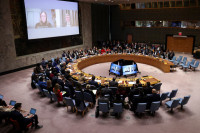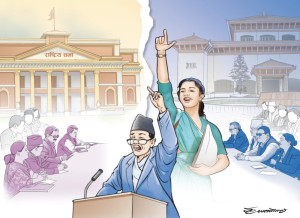Columns
A plethora of pipedreams
Some items in the latest programme have been reappearing unfailingly for the past 30 years.
Achyut Wagle
President Ram Chandra Paudel presented the Nepal government’s Policies and Programmes for the upcoming fiscal year 2023-24 at a joint session of Parliament on Friday. Although any bold departure enabling structural reform in the economy was not expected from the current set of unimaginative political gerontocracy, the government was at least expected to address the unprecedented downturn in the country. There was reason for optimism because this was the new government's first annual policy and programme since the general election in November 2022. Pushpa Kamal Dahal became Prime Minister in December and Paudel became President in March. But these changes in the political leadership did not bring much-needed freshness in the policies and programmes.
The president’s speech was beset with false claims that the economy was headed in the right direction. The reasons given were a comfortable level of foreign exchange reserves, expected increase in workers’ remittance inflows and marginal surplus in the balance of payments. But the projected 1 percent growth rate, near zero rate of employment generation and ever-widening trade deficit were overlooked. Almost in the next breath, the president emphasised immediate measures to maintain macroeconomic stability and deal with the decline in aggregate demand, constrained liquidity position, high interest rates, high inflation, low capital expenditure, low revenue mobilisation and pressure on the external sector.
The misses
Some items in the latest annual programme have been reappearing unfailingly for the last 30 years regardless of the government’s composition or ideology. They include building a chemical fertiliser factory, making farm inputs timely available, promoting import substitution, ensuring timely distribution of textbooks, producing motor vehicles, pursuing planned urbanisation and so forth which never happen. Why did the country fail to make progress in these areas for so long and why do they keep coming up repeatedly? The latest policies and programmes have dealt with them superficially instead of providing any solutions.
One of the major growth constraints has been low resource absorption capacity that is manifested in low capital expenditure. Nepal’s policy-making circle has never made any meaningful effort to identify the real cause and remedy. Agriculture remains the single largest sub-sector in terms of the contribution to the GDP that engages more than two-thirds of the working age population. The government’s policies offer ineffective incentives like subsidies and inputs, but have not backed them up with land management to make large land plots available for commercial agriculture and agro-based enterprises. Land use planning is one area where successive governments have failed.
Import substitution of agricultural products might be the greatest priority to reduce our trade deficit, but the government's policy document fails to identify what exactly the country can produce and market. It is also not clear what exactly Nepal has planned to produce and sell under the “Make in Nepal” and “Made in Nepal” banners. Similarly, attracting foreign direct investment has been a cliche throughout history without doing a review of the reasons behind the unimpressive inflow of funds.
The pitfalls
Some of the proposals like selecting 10 mid-hill cities for planned urbanisation is nothing more than a rude political stunt. The 40 locations identified in the past have now become a travesty of the concept of smart cities. The reason is obvious—token financing. Even to build modest infrastructure and amenities, each town would require at least a billion dollars at the outset and unhindered flow of funds for years to come to maintain the pace of development. Announcing such ambitious schemes at a time when the government coffers are virtually empty was outrightly irrational. The document contains no workable plan to prevent the outflow of capital and youths for higher education. The pressing need to improve university education and generate employment within the country got only a brief mention.
The policies and programmes document contains 109 major development projects that need to be completed, 32 new cost-intensive ventures and 52 proposals to amend or formulate laws. The proposal to invest in reviving a few dilapidated state-owned factories does not have any economic rationale. The document has deeply populist underpinnings with a long list of impossible pipedreams, apparently put together without adequate consideration of the availability of resources. This provides a hint that the next budget will be nothing but a pork barrel since the allocation of budget funds under each of these headings is inevitable. When fiscal discipline, fiscal consolidation and economic efficiency are the need of the hour.




 16.2°C Kathmandu
16.2°C Kathmandu















